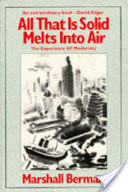
Back Todo lo sólido se desvanece en el aire Spanish تجربه مدرنیته Persian Tout ce qui est solide se volatilise French Tudo que É Sólido Desmancha no Ar Portuguese
This article consists almost entirely of a plot summary. (May 2023) |
 | |
| Author | Marshall Berman |
|---|---|
| Language | English |
Publication date | 1982 |
| Publication place | United States |
| ISBN | 978-0-86091-785-4 |
All That Is Solid Melts Into Air: The Experience of Modernity is a book by Marshall Berman written between 1971 and 1981, and published in New York City in 1982. The book examines social and economic modernization and its conflicting relationship with modernism. The title of the book is taken from Samuel Moore's 1888 translation of The Communist Manifesto by Karl Marx and Friedrich Engels.[1][2][a]
Berman uses Johann Wolfgang von Goethe's Faust as a literary interpretation of modernization, through the processes of dreaming, loving and developing. In the second section he uses Marxist texts to analyze the self-destructive nature of modernization. In the third section French poetry (especially Charles Baudelaire) is used as model of modernist writing, followed by a selection of Russian literature (Alexander Pushkin, Fyodor Dostoevsky, Andrei Bely, Nikolai Gogol, and Osip Mandelstam) in the fourth section. The book concludes with some notes on modernism in New York City during the 1960s and 1970s.[3] New York City's subway map is said to have been designed in accordance with Berman's vision of modernity, presented in the book. Berman recalls: "It was a thrill when the man who had designed New York's marvelous Subway Map came up to me on Broadway, and said that all the time he was putting his map together, he had tried to keep my book in mind."[3]
- ^ Marx and Engels, Collected Works (London, Lawrence and Wishart), vol. 6 (1976), p. 487.
- ^ Marx and Engels (1888). "I. Bourgeois and Proletarians". Manifesto of the Communist Party. Translated by Moore, Samuel.
- ^ a b Berman, Marshall. "All That Is Solid Melts Into Air — Afterword 2010". Globality Studies Journal. 21: 1. Archived from the original (PDF) on 2016-10-05.
Cite error: There are <ref group=lower-alpha> tags or {{efn}} templates on this page, but the references will not show without a {{reflist|group=lower-alpha}} template or {{notelist}} template (see the help page).